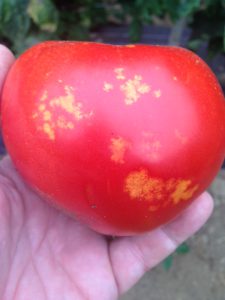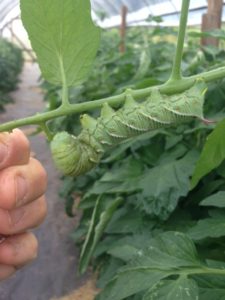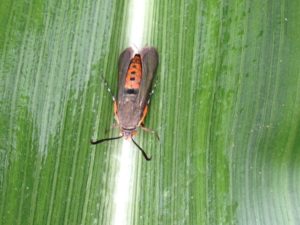Sweet Corn
European corn borer (ECB) moth catches in black light traps continue to be very low. There will be no map in this edition due to insufficient catch. There have been isolated incidents of new feeding in the far south of the state, but generally, the threat to corn should be low until the second flight begins in earnest. Once plants hit full tassel, any ECB larvae present will move downward on the stalk and re-enter the plant near the area where ears are forming. This can result in direct injury to the ear. Growers should consider an insecticide application at the full tassel stage to target ECB larvae as they migrate downward. This application can eliminate larvae that have escaped any earlier insecticide applications.
The highest nightly trap catches of ECB for the week ending 7/11/18 are as follows:
| Eldora 1 |
| Farmingdale 1 |
| Hillsborough 1 |
| Pedricktown 1 |
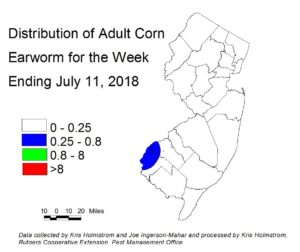 Corn earworm (CEW) moth catches remain very low in black light traps. In addition, the CEW pheromone trap network in the southern counties indicates a very low adult population. At present, both blacklight and pheromone networks indicate the bulk of the activity is along the lower Delaware River shore (see CEW blacklight map at left, and pheromone trap map at lower right). The pheromone trap catch does not directly correspond to the schedule prescribed by the blacklight traps, as the pheromone traps
Corn earworm (CEW) moth catches remain very low in black light traps. In addition, the CEW pheromone trap network in the southern counties indicates a very low adult population. At present, both blacklight and pheromone networks indicate the bulk of the activity is along the lower Delaware River shore (see CEW blacklight map at left, and pheromone trap map at lower right). The pheromone trap catch does not directly correspond to the schedule prescribed by the blacklight traps, as the pheromone traps 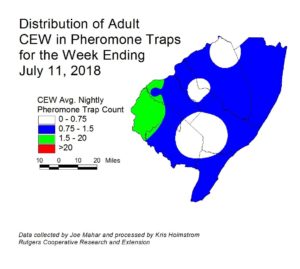 capture males at an increased rate, especially prior to the large migrations of late summer. Additionally, there are many fewer pheromone traps than blacklight traps. This results in much broader colored patches on the pheromone maps. The blue area on the pheromone map indicates an approximate 6 day silk spray schedule, while green would be 4-5 days.
capture males at an increased rate, especially prior to the large migrations of late summer. Additionally, there are many fewer pheromone traps than blacklight traps. This results in much broader colored patches on the pheromone maps. The blue area on the pheromone map indicates an approximate 6 day silk spray schedule, while green would be 4-5 days.
The highest nightly black light trap catches of CEW for the week ending 7/11/18 are as follows:
| Cedarville 1 |
| Pedricktown 1 |
| Woodstown 1 |
The highest nightly pheromone trap catches of CEW for the week ending 7/11/18 are as follows:
| Pedricktown 7 | Woodstown 2 |
| Green Creek 2 | Berlin 1 |
| Monroeville 2 | Jobstown 1 |
Silking Spray Schedules*:
South – 6 days
Central – 6-7 days
North – 7 days
*These recommendations are based on regional catches. Adhere to tighter spray schedules if indicated by local trap catches.
Fall Armyworm
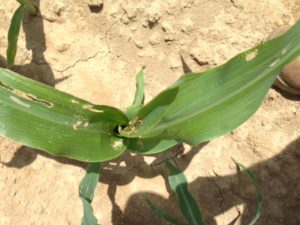 Fall armyworm (FAW) infestations have been discovered in coastal regions from Cape May through Ocean County. As yet, infestations are very light, with clusters of infested whorl-stage plants scattered throughout plantings. This situation can change rapidly, as this pest is highly migratory. Look for significant injury in whorls, with all damage leading directly into the center of the plant (see photo at left). FAW larvae consume lots of tissue, and grow
Fall armyworm (FAW) infestations have been discovered in coastal regions from Cape May through Ocean County. As yet, infestations are very light, with clusters of infested whorl-stage plants scattered throughout plantings. This situation can change rapidly, as this pest is highly migratory. Look for significant injury in whorls, with all damage leading directly into the center of the plant (see photo at left). FAW larvae consume lots of tissue, and grow  rapidly (see photo at right). Be sure to check seedling stage plantings as well, as FAW will attach even small plants. Consider treating if plants infested with FAW alone, or in combination with ECB exceed 12%. FAW is resistant to synthetic pyrethroid insecticides. Effective materials include those in IRAC groups 5 (Radiant, Entrust (OMRI approved)), and 28 (Coragen, Exirel).
rapidly (see photo at right). Be sure to check seedling stage plantings as well, as FAW will attach even small plants. Consider treating if plants infested with FAW alone, or in combination with ECB exceed 12%. FAW is resistant to synthetic pyrethroid insecticides. Effective materials include those in IRAC groups 5 (Radiant, Entrust (OMRI approved)), and 28 (Coragen, Exirel).
Pepper Weevil
No weevils have been trapped in the past week. So far as known, there are no field infestations.
There has been an slight increase in the appearance of native brown stinkbugs injury in tomatoes this past week. As we progress kthrough July, it is worth noting that this is typically the time of the season when our native brown stinkbugs become active; seeking sites on which to feed and lay eggs. This can be an economic problem for our field tomato plantings, and dry conditions will help drive stinkbugs from normal forage sites into irrigated crops. Stink bug feeding results in pale blotches on green fruit, that turn yellow as the fruit ripen to red (see photo at right). Picking crews often notice this damage first, as they see the greatest volume of overall fruit. If this damage is increasing, and/or adults, nymphs or egg masses are occurring in scouting samples, consider treating. See the tomato section of the 2018 Commercial Vegetable Recommendations Guide for appropriate materials.
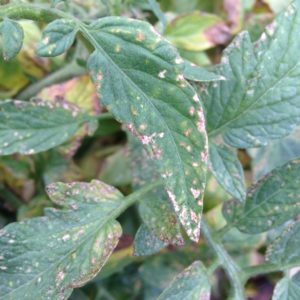 Thrips injury is on the increase in tomato fields visited by IPM scouts. Growers should be on the lookout for foliar (see photo at left) and fruit injury (photo at right). The presence of foliar
Thrips injury is on the increase in tomato fields visited by IPM scouts. Growers should be on the lookout for foliar (see photo at left) and fruit injury (photo at right). The presence of foliar 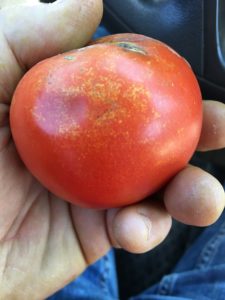 feeding should serve as a warning that fruit injury may follow. Excessive heat and dry weather will cause populations to increase rapidly, and fruit blemishes may follow as thrips begin to feed there. If these types of feeding are occurring, consider an insecticide application to minimize injury. Labeled products are found in the tomato section of the 2018 Commercial Vegetable Recommendations Guide.
feeding should serve as a warning that fruit injury may follow. Excessive heat and dry weather will cause populations to increase rapidly, and fruit blemishes may follow as thrips begin to feed there. If these types of feeding are occurring, consider an insecticide application to minimize injury. Labeled products are found in the tomato section of the 2018 Commercial Vegetable Recommendations Guide.
Tomato hornworm (THW) (see photo at left) are now impacting plants in high tunnels and in the field. While injury from this pest (stripping of leaflets and damage to green fruit) often looks more significant than it actually is, growers of high tunnel tomatoes may consider treating if THW is threating to consume an unacceptable number of fruit. THW are easily managed with insecticides in the IRAC 5 and 28 groups (see FAW section above).
Brown marmorated stink bug (BMSB)
BMSB catches in black light traps decreased again in NJ this past week. No map image will appear in this addition. Although this pest has not had serious impact on vegetable crops like peppers in recent years, it is still a significant pest of tree fruits.
The highest nightly trap catches of BMSB for the week ending 7/11/18 are as follows:
| Centerton 1 |
| Milltown 1 |
| Old Bridge 1 |
| Pedricktown 1 |
Squash vine borer moths are active now, and may cause injury to crops like summer squash. The moth (see photo at right) is typically active at dawn and dusk, and will lay eggs on the base plants that have sufficient stem width to support the larva. Larvae hollow out the main stem, causing a wilt condition to occur. Insecticides in the IRAC classes 28 (Coragen, Exirel), 5 (Radiant, Entrust (OMRI approved)) and 4A (Assail) may be used effectively against this pest, but should be applied weekly while moths are active. Other materials are also labeled and may be found in the Summer Squash section of the 2018 Commercial Vegetable Production Recommendations Guide. Generally, 4 applications at weekly intervals are enough to avoid most injury from this pest during the egg laying period.
Pumpkins and Winter Squash
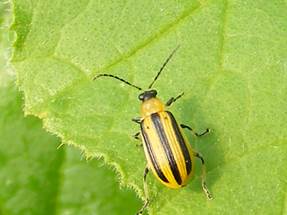 Pumpkins are now up in many areas. It is critical that these fields be scouted while plants are in the 0-4 true leaf stage. Striped cucumber beetle (see photo at left) is the most serious pest of these crops in this stage, not only because they cause direct injury to seed leaves and true leaves, but because at this stage, the beetles can transmit the bacteria that cause in bacterial wilt. Check 5 plants each in 10 random locations. If beetles are found actively feeding in 2 or more sites, consider an insecticide application to reduce the likelihood of bacterial wilt setting in later. Many pumpkin and winter squash seeds are purchased with a seed treatment that includes a neonicotinoid insecticide. In this case, cucumber beetle feeding should be seriously limited for the first 2-3 weeks of growth. This is typically long enough to get the plants close to the stage where vines begin to run or bush out. At this point, it is much more difficult for the plants to acquire a large enough bacterial load from the beetles to cause wilt. Organic growers of these crops should consider covering plants from emergence through just before vine run. This should limit beetle feeding and permit bee access to blossoms when the covers come off.
Pumpkins are now up in many areas. It is critical that these fields be scouted while plants are in the 0-4 true leaf stage. Striped cucumber beetle (see photo at left) is the most serious pest of these crops in this stage, not only because they cause direct injury to seed leaves and true leaves, but because at this stage, the beetles can transmit the bacteria that cause in bacterial wilt. Check 5 plants each in 10 random locations. If beetles are found actively feeding in 2 or more sites, consider an insecticide application to reduce the likelihood of bacterial wilt setting in later. Many pumpkin and winter squash seeds are purchased with a seed treatment that includes a neonicotinoid insecticide. In this case, cucumber beetle feeding should be seriously limited for the first 2-3 weeks of growth. This is typically long enough to get the plants close to the stage where vines begin to run or bush out. At this point, it is much more difficult for the plants to acquire a large enough bacterial load from the beetles to cause wilt. Organic growers of these crops should consider covering plants from emergence through just before vine run. This should limit beetle feeding and permit bee access to blossoms when the covers come off.
Cucurbit Downy Mildew
 As of last week, cucurbit downy mildew (CDM) had been discovered on cucumbers in Delaware and in Salem Co. NJ (see Dr. Wyenandt’s disease update of 7/2/18). CDM causes yellow “panels” to develop on the upper leaf surface (see photo at left) with dark sporulation forming on the lower leaf surface (see photo at right). CDM can defoliate fields in a matter of several days should the weather turn wet. To date, the only reported incidence of this disease has been on cucumbers, and all growers should be treating preventively for CDM on that crop. No pumpkin fields have yet been found to be infected in our region. A sentinel plot of mixed
As of last week, cucurbit downy mildew (CDM) had been discovered on cucumbers in Delaware and in Salem Co. NJ (see Dr. Wyenandt’s disease update of 7/2/18). CDM causes yellow “panels” to develop on the upper leaf surface (see photo at left) with dark sporulation forming on the lower leaf surface (see photo at right). CDM can defoliate fields in a matter of several days should the weather turn wet. To date, the only reported incidence of this disease has been on cucumbers, and all growers should be treating preventively for CDM on that crop. No pumpkin fields have yet been found to be infected in our region. A sentinel plot of mixed 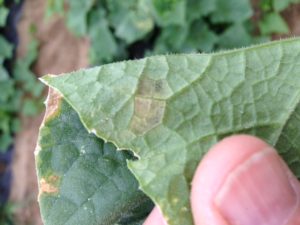 cucurbits, (cucumbers, pumpkin, butternut and acorn squash, muskmelon and watermelon) has been established at Snyder Research and Extension Farm in Hunterdon County. Another of these plots is at RAREC. These unsprayed plots are designed to alert growers to the presence of CDM in the area and WHAT CROP(s) are impacted. Many growers in the northern NJ counties have limited acreage of cucumbers, but extensive pumpkin acreage. For this reason we go to great lengths to determine host occurrence so that fungicide programs are not initiated unnecessarily. For detailed CDM forecasts, see the following website: http://cdm.ipmpipe.org/ All growers are encouraged to check this website at least once a week.
cucurbits, (cucumbers, pumpkin, butternut and acorn squash, muskmelon and watermelon) has been established at Snyder Research and Extension Farm in Hunterdon County. Another of these plots is at RAREC. These unsprayed plots are designed to alert growers to the presence of CDM in the area and WHAT CROP(s) are impacted. Many growers in the northern NJ counties have limited acreage of cucumbers, but extensive pumpkin acreage. For this reason we go to great lengths to determine host occurrence so that fungicide programs are not initiated unnecessarily. For detailed CDM forecasts, see the following website: http://cdm.ipmpipe.org/ All growers are encouraged to check this website at least once a week.
